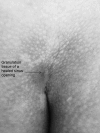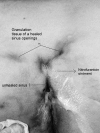Minimally invasive treatment of pilonidal disease: crystallized phenol and laser depilation
- PMID: 23294066
- PMCID: PMC3727265
- DOI: 10.9738/CC130.1
Minimally invasive treatment of pilonidal disease: crystallized phenol and laser depilation
Abstract
Pilonidal disease has been treated surgically and by various other methods for many years. The most important problem associated with such treatment is recurrence, but cosmetic outcome is another important issue that cannot be ignored. Today, crystallized phenol is recognized as a treatment option associated with good medical and cosmetic outcomes. We hypothesized that the addition of laser depilation to crystallized phenol treatment of pilonidal disease might increase the rate of success, and this study aimed to determine if the hypothesis was true. Patients who were treated with crystallized phenol and 755-nm alexandrite laser depilation were retrospectively analyzed. In total, 42 (31 male and 11 female) patients were treated with crystallized phenol and alexandrite laser depilation and were followed up between January 2009 and January 2012. In all, 38 patients (90.5%) had chronic disease and 4 (9.5%) had recurrent disease. Among the patients, 26 (61.9%) recovered following 1 crystallized phenol treatment, and the remaining patients had complete remission following repeated treatment. Some patients needed multiple treatments, even up to 8 times. None of the patients had a recurrence during a mean 24 months (range, 6-30 months) of follow-up. Whatever method of treatment is used for pilonidal disease, hair cleaning positively affects treatment outcome. The present results support the hypothesis that the addition of laser depilation (which provides more permanent and effective depilation than other methods) to crystallized phenol treatment (a non-radical, minimally invasive method associated with very good cosmetic results) can increase the effectiveness of the treatment and also reduce the recurrence rate of the disease.
Figures
References
-
- Anderson AW. Hair extracted from an ulcer. Boston Med Surg J. 1847;36:74–76.
-
- Hodges RM. Pilonidal sinus. Boston Med Surg J. 1880;103:485–486.
-
- Aslam MN, Shoaib S, Choudhry AM. Use of Limberg flap for pilonidal sinus—a viable option. J Ayub Med Coll Abbottabad. 2009;21(4):31–33. - PubMed
-
- Chintapatla S, Safarani N, Kumar S, Haboubi N. Sacrococcygeal pilonidal sinus: historical review, pathological insight and surgical options. Tech Coloproctol. 2003;7(1):3–8. - PubMed
-
- Jaschke CW, Marhlein R, Mangold G. Results of the Limberg transposition flap in the treatment of pilonidal sinus. Journal Name Abbreviation. 2002;127(8):712–715. - PubMed
Publication types
MeSH terms
Substances
LinkOut - more resources
Full Text Sources
Other Literature Sources



